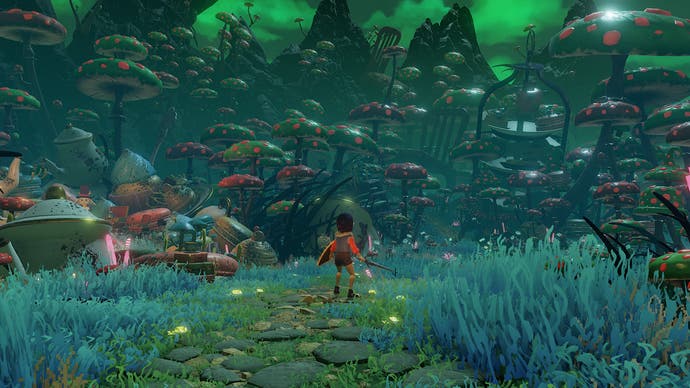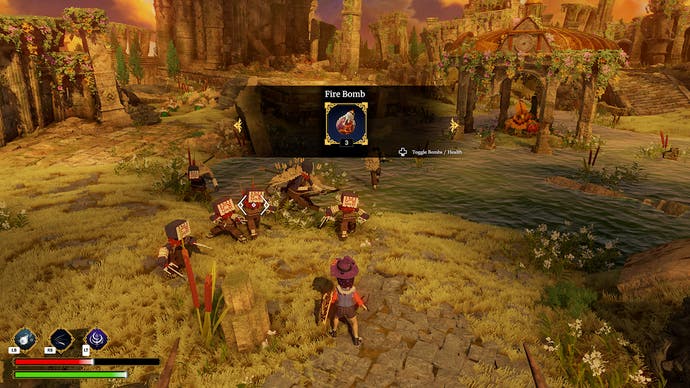A beautiful but rather hollow and one-note journey into a familiar world of wonder and mismanagement.
Take a look at Ravenlok and you’ll see Lewis Carroll’s fingerprints embedded in every voxel. The two literary adventures of Alice in Wonderland (along with several other adaptations) have clearly influenced developer Cococucumber, from the oversized teapots, off-brand Queen Of Hearts, and the fish-out-of-water setup in a storybook world. fairies. Ravenlok shares more than just nods to this classic book, though. Yes, it’s beautiful and dreamlike, but it’s as disorganized and absurd as Alice’s growing brain – for better and for worse.
Ravenlok Review Publisher: Cococucumber Developer: Cococucumber Platform: Played on Xbox Series X Availability: Coming to PC and Xbox May 4
Ravenlok is another gorgeous voxel adventure from Cococucumber, the delightfully named studio behind Echo Generation, but this time the turn-based combat is replaced with real-time cutting, and the retro 80s vibes are replaced with a world of storybook. The journey begins with your heroine relaxing under a tree in the ordinary old world, before passing through a strange mirror and entering the magical world of Dunia. A White Rabbit quickly explains that she is the Indescribable Chosen One, the titular Ravenlok, and you are then quickly dispatched to deal with the Evil Queen plaguing the world.
What follows is an endless cycle of MacGuffin after MacGuffin that’s so deep you almost forget why you’re tumbling down that rabbit hole. As you’re pushed through a series of fetch quests, the game skips through important events and quickly drops potentially interesting characters, meaning everything feels paper-thin. Even Ravenlok (the hero, not the game) feels a note, as she was never given enough time to meaningfully interact with the wacky cast; most of her conversations are polite and frictionless, almost as if she’s keeping us at bay. The credits roll by before you really understand how the world works or who these colorful characters are.
Ravenlock trailer.
On the other hand, though, that quick pace gives Ravenlok its dreamy quality. Since we never stay in one place too long, the game is free to constantly create new environments, new ideas, and new circumstances. It rarely makes sense, but Wonderland was never a sensible place anyway. Everything lacks elaboration, but this allows Cococucumber to give you interesting views without interruption.
I have already mentioned the beauty of the world, but it is worth pointing out. It’s a collision of expressive voxels, epic painterly skies, a heavy dose of beautiful lighting, and it all adds up to great sensory overload. The game also revels in smaller venues, whether it’s the quirky character designs, the absolutely packed decorations, or even your character’s ability to dance at all times. Ravenlok’s audio-visual effort does a lot of work to infuse the game with personality. Sure, every environment is littered with Alice iconography, but there’s always something a little more added. A little off.
Ravenlock.
Do you remember that mushroom from Alice? Well, Ravenlook has an entire forest full of luminescent mushrooms – really putting the magic into magic mushrooms. How about the hedge maze from the Disney movie? It’s here, it’s pretty, and there’s also a demonic fanged cave entrance hanging off the side. In this way, Cococucumber continues the deadpan spirit of Echo Generation where everything initially seems innocent, even if it’s really a little twisted on the inside – it probably helps that everyone’s eyes are actually deadpan, despite their cheerful smiles. Essentially, each new environment in Ravenlok makes you want to stop and stare, to appreciate either a grand view or the little hidden details.
A mostly fixed camera angle works hard to frame the world at the most appealing angles, but it’s a major hindrance when it comes to combat, unfortunately. When fighting regular enemies – through Ravenlok’s hallway-like levels – the camera is fine. It only becomes problematic in boss battle arenas when towering baddies are running behind your line of sight. Rather than turning to look at them, as you would in most action games, you instead have to run into the unknown, which could put you in danger.
Unfortunately, that’s just one of many frustrations with Ravenlok’s feather-light combat. You have a sword for standard attacks, a shield to reduce incoming damage, a few bombs that pause the action while you select them, and a handful of flashy magic abilities that fire icy projectiles or cover the ground in flames. Despite these options, most one-on-one fights turn into a button-mash fest. Ravenlok’s sword swing doesn’t really have a long animation: the faster you can press the attack, the faster it will swing its sword. Since common enemies are usually stunned when you attack them, you can essentially intimidate them with a non-stop flurry of blows, turning battles into busy work. Group encounters are no longer dynamic, as the same button mashing is intact, but instead you’ll have to dodge and switch targets to avoid damage, which only serves to lengthen the same process.
Ravenlock.
The main problem is simply the monotony that sets in. Rather than feeling like a reactive dance – a dance where you learn an enemy’s behavior and react to their moves accordingly – combat in Ravenlok is almost always one-sided.
Boss fights fare a little better – when in sight – since they aren’t so easily knocked back and have their own cycle of moves that you can learn, dodge, and counter. In that sense, the boss fights feel pretty old-school; almost as if it were an obstacle course to fail and try again. Unfortunately, most of the time the combat has no learning curve, just some nice flashy effects. That sums up most of Ravenlok, I think.
With the sword swinging aside, there are also a handful of clever puzzles here too. The best require you to pull out your inner detective hat, and sometimes your actual notebooks, to investigate the environment for clues, find patterns in paintings to crack a code, for example. It was so much fun because they encouraged me to take a closer look at this wonderful world and the little details that I would have otherwise missed. I wish the game was filled with more of these exploratory puzzles because it leverages Ravenlok’s strengths and really lets you soak up the magic.
Ravenlock.
All in all, my time with Ravenlok can be summed up pretty well with the original Alice’s Adventures In Wonderland book. It ends in a relevant way for this game: the King and Queen of Hearts hold a trial for an innocent man using an illogical, nearly illegible poem as evidence. Having found a new perspective through her journey, a braver, bolder, and literally bigger Alice stands up for the innocent, arguing that the evidence makes no sense. It’s a debate that followed the book into the real world – was this trippy romance childish nonsense, or could it have deeper connotations?
It was a question that kept popping into my head during this game as well, although the answer here is probably the first one. Ravenlok never sits in the moment, never bothers to ask if there’s any meaning to madness, never twists language in the “increasingly curious” way. Ultimately, my lasting memory of the game is a fuzzy collection of visual snapshots, and that was admittedly enough to hold me to an 8-hour playthrough. It’s endlessly alluring to look at and think about, though scratch below the surface and you won’t find much else to grab hold of.
To view this content, please enable targeting cookies. Manage cookie settings
Article source https://www.eurogamer.net/ravenlok-review-haste-makes-waste-in-wonderland






